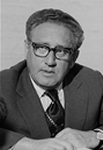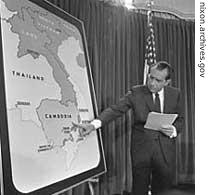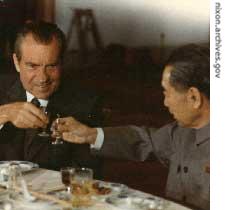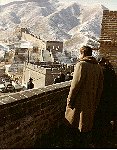VOA慢速英语 2007 0517b
搜索关注在线英语听力室公众号:tingroom,领取免费英语资料大礼包。
(单词翻译)
VOICE ONE:
This is Rich Kleinfeldt.
VOICE TWO:
And this is Doug Johnson with THE MAKING OF A NATION -- a VOA Special English program about the history of the United States.
(MUSIC)
Today, we continue the story of the thirty-seventh president of the United States, Richard Nixon.
(MUSIC)
VOICE ONE:
It is nineteen sixty-nine in America. Richard Nixon is in the first year of his first term in office. His biggest foreign policy problem is the continuing war in Vietnam.
During the election campaign, he had promised to do something to end the war. Some Americans believe the United States should withdraw from Vietnam immediately. Bring the soldiers back home, they say.
Others believe the United States should take whatever measures are necessary to win. Expand the ground war, they say, or use nuclear weapons.
VOICE TWO
The decision is not easy. Withdrawing allied1 troops would leave South Vietnam alone to fight against communist North Vietnam. And that was the reason the United States became involved in the conflict. It wanted to prevent the Communists from taking over the South. Expanding the military effort would mean more deaths.
Already, by nineteen sixty-nine, more Americans had died in Vietnam than in the Korean War.
VOICE ONE
For Richard Nixon, the war is a terrible test. If he is not able to deal with it, his presidency2 could end like Lyndon Johnson's ended. Johnson decided3 not to run for re-election after he lost public and political support for his war policies.
 |
| Henry Kissinger |
Together, they tried many ways to settle the conflict in Vietnam. It took several years to end American involvement there.
VOICE TWO:
The American efforts were both diplomatic and military. The Nixon administration started new, secret peace talks in Paris. The official peace talks were taking place in Paris at the same time. The administration withdrew some troops from Vietnam.
Yet it sent other troops into Cambodia secretly. And it began dropping bombs on Laos. It also started dropping bombs on North Vietnam again. Former president Johnson had stopped the bomb attacks a few years earlier.
(MUSIC)
VOICE ONE
Efforts to end American involvement did not begin suddenly. For his first eight months in office, President Nixon made no major policy changes. Then, in October nineteen sixty-nine, he ordered the withdrawal6 of sixty thousand troops.
He said he acted to speed the peace talks. He also ordered American commanders to give the South Vietnamese most of the responsibility for fighting.
VOICE TWO:
Americans were happy that fewer troops would be involved. But many were unhappy that the withdrawal was not complete. Huge anti-war demonstrations7 took place in the United States in the autumn of nineteen sixty-nine. On November fifteenth, several hundred thousand people protested in Washington, D.C.
 |
| 1970: President Nixon announces the Cambodian invasion in a speech to the American people |
VOICE ONE:
In the spring of nineteen seventy, American and South Vietnamese troops invaded Cambodia. They attacked Communist supply centers there. Early the following year, the Nixon administration decided to provide air and artillery8 support for a South Vietnamese invasion of Laos. The goal was to stop supplies from reaching North Vietnam through that country.
The military action in Laos lasted forty-four days. South Vietnamese forces destroyed many enemy weapons. However, they also suffered many deaths and injuries. And many American planes were shot down. After six weeks, the South Vietnamese were forced to withdraw.
VOICE TWO:
Many members of the United States Congress were angry. They said the invasion of Laos was another in a long series of failures. The Nixon administration had said that the United States was winning the war. Opposition9 lawmakers said the administration was lying. Criticism by the American public grew louder, too.
President Nixon answered by saying again that the United States must not permit North Vietnam to take over South Vietnam. Former president Johnson had said the same thing. For a long time, many Americans accepted it. As the war continued, however, public opinion changed.
In nineteen sixty-five, sixty-one percent of those questioned approved the war. By nineteen seventy-one, sixty-one percent did not approve.
(MUSIC)
VOICE ONE:
The official peace talks in Paris offered little hope of settlement. Over a period of several years, each side made proposals. Then each side rejected the proposals. One American observer said: "As long as either side thinks it can win a military victory, there is no hope for official peace talks."
President Nixon wanted to ease public tension and anger over the war. So he announced that Henry Kissinger had held twelve secret meetings with North Vietnamese officials. But the secret meetings made no more progress than the official talks.
VOICE TWO:
In late March nineteen seventy-two, North Vietnam launched a major offensive. In May, Nixon ordered increased bomb attacks against roads and railways in the North. By the end of August, the communist offensive had been stopped. Yet many lives had been lost. The pressure to withdraw American forces grew stronger.
For the next five months, the Nixon administration continued a policy of official talks, secret meetings, and increased military action. Finally, the president announced that an agreement had been reached at the peace talks in Paris. There would be a ceasefire. And negotiators from the United States, South Vietnam, North Vietnam, and the Viet Cong would sign the official agreement.
VOICE ONE:
Under the terms of the agreement, all American and allied forces would withdraw from South Vietnam. The North and South would be free to settle their conflict without interference from other countries. President Nixon made the official announcement from the White House.
RICHARD NIXON: "At twelve-thirty Paris time today, January twenty-three, nineteen seventy-three, the agreement on ending the war and restoring peace in Vietnam was initialed by Doctor Henry Kissinger on behalf of the United States and special adviser Le Duc Tho on behalf of the Democratic Republic of Vietnam. The agreement will be formally signed by the parties participating in the Paris conference on Vietnam on January twenty seven, nineteen-seventy-three, at the international conference center in Paris. ...
"The United States and the Democratic Republic of Vietnam express the hope that this agreement will insure stable peace in Vietnam and contribute to the preservation10 of lasting11 peace in Indochina and Southeast Asia."
(MUSIC)
VOICE TWO:
Another foreign policy problem during the Nixon administration was China. The president had much greater success dealing12 with this problem than with Vietnam. Communists took power in China in nineteen forty-nine. However, the United States did not recognize the Communist government. Instead, it recognized the Nationalist government in Taiwan.
In the early nineteen seventies, the Nixon administration began trying to improve relations. It eased restrictions13 on travel to China. And it supported a visit to China by the United States table tennis team. Then, President Nixon made a surprise announcement. He, too, would visit China.
 |
| With Chou En-lai in 1972 |
The historic event took place in February, nineteen seventy-two. Chinese leaders Mao Zedong and Zhou En-lai greeted the American president. Nixon and Zhou held talks that opened new possibilities for trade. The next year, Nixon sent a representative to open a diplomatic office in Beijing. After more than twenty years, the two countries were communicating again. They established official relations in nineteen seventy-nine.
VOICE TWO:
Many Americans expressed pleasure that tensions between the two countries had decreased. Many were proud to see their president standing14 on the Great Wall of China.
 |
| And at Great Wall |
(MUSIC)
VOICE ONE:
This program of THE MAKING OF A NATION was written by Jeri Watson and produced by Paul Thompson. This is Rich Kleinfeldt.
VOICE ONE:
And this is Doug Johnson. Join us again next week for another VOA Special English program about the history of the United States
 收听单词发音
收听单词发音 




